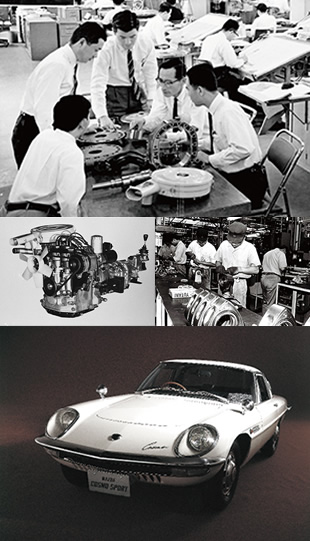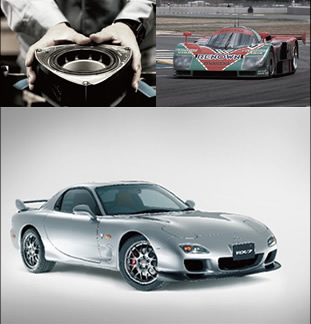

マツダのクルマづくりは、常に挑戦の歴史でした。誰もが不可能だと思うことに敢えて挑み、大きな困難や高い壁に当たっても、決して諦めずに打ち破っていく。このマツダの「飽くなき挑戦」の精神をもっとも象徴しているのが、ロータリーエンジンの実用化です。
1961年から始まったマツダとロータリーエンジンの歴史は、開発の当初から多くの難問が立ちはだかりました。それでも開発陣は志をひとつとし、一切妥協することなく、あらゆる可能性に挑戦しながらロータリーエンジン実用化への道を切り拓いたのです。そして1967年、ついに世界初の2ローター・ロータリーエンジン搭載車「コスモスポーツ」を発表します。それは自動車史に残る快挙であり、マツダの新たな「走る歓び」が誕生した瞬間であり、そして、さらなる挑戦の始まりでもありました。
1973年、第1次オイルショック。低燃費なクルマが注目されるようになると、ロータリーエンジンの燃費性能が大きくクローズアップされます。ロータリーエンジンから撤退すべきとの批判の声が上がる中、マツダの新たな挑戦が始まります。「ここでやめれば、マツダファンへの信義を欠く。技術で失ったものは技術で取り戻す」。この志のもと、40%もの燃費向上を誓った「フェニックス計画」をスタート。
わずか4年で、それまでの常識をくつがえす燃費性能と走りの楽しさを両立したスポーツカー「サバンナRX-7」を生み出し、ロータリーエンジンはまさに不死鳥のごとく甦ったのです。
また、マツダのロータリーエンジンへの挑戦の中で、もっとも有名なのがル・マン24時間耐久レースです。1991年、700馬力、4ローターエンジンを搭載したマツダ787B、日本車初の総合優勝。参戦開始から18年、13回ものチャレンジを積み重ねて勝ち取った栄冠でした。ロータリーエンジンの開発そのものから始まったマツダの飽くなき挑戦は、燃費問題への取り組みでも、モータースポーツ活動でも、いつだって、必ず成果として結実してきたのです。
現在、ロータリーエンジンを開発しているのは、世界で唯一マツダのみ。さらなる進化を求めても教科書も資料もなく、まさに未知の技術への挑戦です。しかしマツダには、受け継いできた飽くなき挑戦のスピリットが息づいています。
常識をくつがえしたロータリーエンジンがあったからこそ、革新のスカイアクティブ テクノロジーが生まれました。
そしてそのチャレンジは、くつがえした常識をさらに超える次世代ロータリーエンジンへとつながっていくのです。
マツダがマツダであるために。「走る歓び」を追求するクルマづくりへの、飽くなき挑戦が絶えることはありません。


Mazda’s history as a car builder has also been a history of challenge. Daring to defy convention and take on challenges that others thought impossible, Mazda has constantly broken through the barriers, even when facing difficult problems or tall hurdles. Most symbolic of this “never stop challenging” spirit is Mazda’s bringing the rotary engine to production vehicles.
Since its inception in 1961, development of the rotary engine presented many difficulties. Despite this, the development team was of one mind, refusing to compromise and challenging every possibility while clearing the way to commercialize the rotary engine. In 1967, Mazda debuted the Cosmo Sport, the world’s first production car powered by a two-rotor rotary engine. It was a splendid achievement within the history of automotive production, the moment that Mazda’s trademark “driving pleasure” was born, and the beginning of a long history of tackling challenges at Mazda.
Enter the first oil shock in 1973. As attention focused on cars that delivered good fuel economy, it also brought attention to the fuel consumption of the rotary engine. In the face of critical voices calling for abandoning the rotary engine, Mazda began a new challenge. “If we quit now, we will be betraying the loyalty of our fans. What we lost due to technological challenges, we will regain with technology.” Based on this resolve, Mazda launched Project Phoenix with a vow of achieving a 40% improvement in fuel economy. In four short years, the rotary engine rose from the proverbial ashes when Mazda launched the Savanna RX-7, defying convention by delivering a winning combination of fuel economy and driving pleasure.
The most famous out of Mazda's various challenges thorough the rotary engine technology must be its victory in the 24 Hours of Le Mans endurance race. In 1991, the 700-horsepower, four-rotor-engine Mazda 787B became the first Japanese car to emerge as the overall winner at Le Mans. It was a crowning achievement after competing in the race 13 times over 18 years. Mazda’s tireless challenge, which began with the initial development of the rotary engine, has produced solid results at each step, from resolving the problem of fuel economy to success in motorsports.
At present, Mazda is the only carmaker in the world developing the rotary engine. It is a challenge for which no textbooks exist and a journey into the unknown as we work toward further evolving the technology. However, Mazda faces this with the same “never stop challenging” spirit that has been passed down through generations of engineers. It is precisely because Mazda defied convention in developing the rotary engine that consequently gave birth to SKYACTIV TECHNOLOGY. And, it is that same challenging spirit that will once again defy convention as Mazda works to develop the next-generation rotary engine.
At Mazda, the “never stop challenging” conviction to deliver pure driving pleasure will never wane. That is what makes us Mazda.














